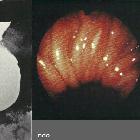Barrett-Ösophagus
Barrett esophagus is a term for intestinal metaplasia of the esophagus. It is considered the precursor lesion for esophageal adenocarcinoma.
Epidemiology
Barrett esophagus is thought to have a prevalence of 3-15% in patients with reflux esophagitis. Mean age at diagnosis is 55 years old . Risk factors of Barrett esophagus includes male gender, tobacco intake, central obesity and white race .
Scleroderma is thought to be a risk factor, with ~37% of patients (n = 27) who underwent upper endoscopy were found to have Barrett esophagus .
Clinical presentation
Asymptomatic. Usually discovered in a workup for GERD.
Pathology
Barrett esophagus represents progressive metaplasia of esophageal stratified squamous cell epithelium to columnar epithelium. Although the exact number varies, 90-100% of esophageal adenocarcinoma is thought to arise from this metaplasia.
Although patients with Barrett esophagus have a 30x risk of developing esophageal adenocarcinoma , the annual risk of developing adenocarcinoma depends on the degree of histological dysplasia, but may be ~1% (range 0.1-2%), and the absolute risk is low .
Radiographic features
Because Barrett esophagus represents metaplasia, it is often occult on imaging. Early esophageal adenocarcinoma arising out of Barrett esophagus also may be difficult to see. Radiographic imaging modalities are not adequate for screening.
Fluoroscopy
- double-contrast esophagogram
- signs of reflux esophagitis
- reflux
- long stricture in the mid or lower esophagus
- large deep solitary ulcer
- fine reticular mucosal pattern
- thickened irregular mucosal folds
- earliest signs of developing adenocarcinoma: localized flattening, stiffening, or irregularity in the wall of a stricture
- signs of reflux esophagitis
There is a ~70% chance of Barrett esophagus in a midthoracic esophageal stricture.
Treatment and prognosis
Since Barrett esophagus is considered a premalignant lesion, confirmation with upper endoscopy and biopsy is warranted.
If Barrett esophagus is confirmed on biopsy, then aggressive therapy for gastro-esophageal reflux is pursued, and perhaps endoscopic surveillance, depending on the patient's age and other risk factors.
One surveillance and biopsy protocol suggests :
- low-grade dysplasia: 6-12 months
- high-grade dysplasia: 3 months
If there is mucosal irregularity (what would be seen on an esophagogram), then endoscopic resection has been recommended . Prophylactic resection or ablation has been used by some, particularly in younger patients.
History and etymology
It is named after Norman Rupert Barrett (Australian born thoracic surgeon) first described the condition in 1950 .
Siehe auch:
und weiter:

 Assoziationen und Differentialdiagnosen zu Barrett-Ösophagus:
Assoziationen und Differentialdiagnosen zu Barrett-Ösophagus:



